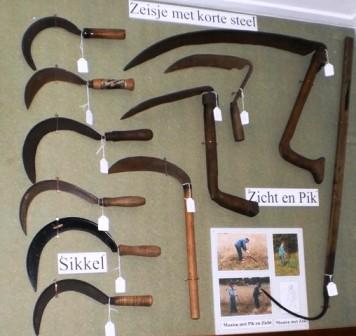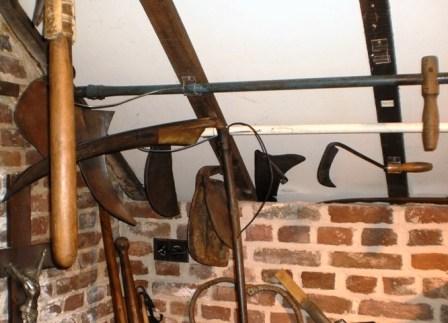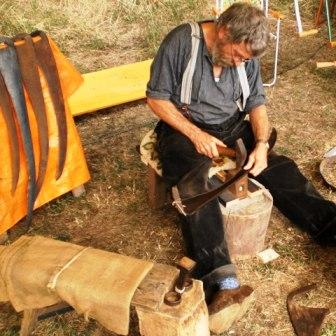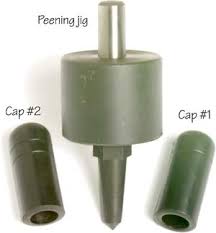To help cattle (grazers) trough the winter you need (mountains of) hay. Dry grass can be compared to dry herbs. It is a hellish and endless work to mow, dry and collect. It may seem romantic, and modern tractors and machines can handle hectares per day. But if you are using simple tools this is hard labor. And all hands on deck: family, neighbors.... The hay should be in before a rain shower comes again. That gives us in our country so little time and a lot of pressure.
Sickle and scythe
 A sickle is a small, strongly curved, crescent-shaped blade with a handle. It is one of the oldest tools. You mow kneeling or bent grass and grain with it. She was in ancient times used to harvest grain. A sickle was often made from a single piece of deer antler set with sharp flint flakes. And later bronze (and iron).
A sickle is a small, strongly curved, crescent-shaped blade with a handle. It is one of the oldest tools. You mow kneeling or bent grass and grain with it. She was in ancient times used to harvest grain. A sickle was often made from a single piece of deer antler set with sharp flint flakes. And later bronze (and iron).
With a sickle 0,3 ha grain could be harvested per day. With big brother scythe that may be 0.4 ha by the leverage. When the stem end of the 15th century got wooden protrusions (nibs, handles on the snath) could be cut and collected in one motion. That doubled productivity.
(A horse drawn reaper in 1831 did the work of 10 men.)
The scythe has a broad, slightly curved long leaf (6o - 90 cm) and long transverse stem with two handles.
There is also an intermediate form: the grass hook, with the blade of a scythe, and a short 1meter snatch with a grip used with one hand, the other moving the pick. The corn was in the same pass collected with the hook in a bundle (or sheaf) reaped and discarded.
Mowing with a scythe you have to learn. Place the handles at the correct height and position for your posture and method. It's not a daily activity, so wear gloves to avoid blisters. (That probably will not work.) You need the grass cut into narrow strips, not cut smashing down, thus cutting into loops.
The scythe adjustment Place the heel of the scythe on the ground in front of you. Turn the handles so you can hold the scythe comfortable: T for the left at about 9 pm, the right hand stalk directed to about 11 hours. Place the blade so that the heel remains in touch with the ground, and the full blade sheeting continues to hoover if you make small circular movements from the hips (not (just) the arms or shoulders) (from about 2 hours to 10 hours). Try to fix the blade deadlocked (rubber spacer under the screw aside... wooden wedge aside the tang).
Place the heel of the scythe on the ground in front of you. Turn the handles so you can hold the scythe comfortable: T for the left at about 9 pm, the right hand stalk directed to about 11 hours. Place the blade so that the heel remains in touch with the ground, and the full blade sheeting continues to hoover if you make small circular movements from the hips (not (just) the arms or shoulders) (from about 2 hours to 10 hours). Try to fix the blade deadlocked (rubber spacer under the screw aside... wooden wedge aside the tang).
You should therefore regularly, even often grind the scythe a little. Sweep the blade several times with a soft stone above and below. Remain cautious, a scythe even cuts through meat! The time you invest in good adjustment and sharpening, you win back 50 times.
 The scythe has to be peened regularly. The cutting edge of an uncured blades of high quality steel is knocked flat and thin with a hammer on small field anvil to razor sharp and hard it. It requires a very specific technique (thin material crushing, without letting it expand in the longitudinal direction). The field anvil is a kind of chisel with midway a thickening or cross-piece, so that it is not hammered deeper into the ground.
The scythe has to be peened regularly. The cutting edge of an uncured blades of high quality steel is knocked flat and thin with a hammer on small field anvil to razor sharp and hard it. It requires a very specific technique (thin material crushing, without letting it expand in the longitudinal direction). The field anvil is a kind of chisel with midway a thickening or cross-piece, so that it is not hammered deeper into the ground.
Peening a scythe can also with a jig. There are several forms. The most common resembles a spinning top -like, thick gate hinge: a pin mounted in a cylinder. (Which can be beaten with the sharp bottom in a log). Thereupon fits the upper part of the 'hinge'. Focus the scythe between the two parts from front to back, and in the meantime but hammering. Consequently, the blows are always well placed. Often there is a 2nd jig with a narrower circle. Keep the cutting edge while peening flat, so that the cut remains straight.
Use on mowing minimal power (but good (adjusted) material). Mowing is done by making from shoulders and hips wide circular movements. Hold the heel of the scythe (back) to the ground, and the point a little up. Find a cadence in mowing: put the grass in small ribbons together and make small steps forward. Think in centimeters, not meters.
You can normally harvest two cuts per season, the first around the end of June and the second in August.
A swath is a cut, the amount of grass or wheat that in one go with the scythe was cut and placed in a line. (Agricultural machinery also work per swath, so as to make room for the next driving mode.)
There are wonderful machines for mowing and returning. If you can hang these things behind a horse or tractor you win an incredible amount of time.
Lawn grass clippings are not suitable. It's too short, is thus in slices sticked onto each other and goes moldy. Pay attention to the weather to start at an appropriate time.
Do not mow dry grass. The scythe is faster bone. Mow wet, in the morning when the grass is fresh and firm upright. A wooden snatch and /or grips feel then nicer than cold metal parts. It's okay to make hay to mow dryer so that the grass does not stay wet in bundles.
